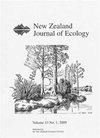Knowing when native regeneration is for you, and what you should do about it. The Aotearoa New Zealand context
IF 1.4
3区 环境科学与生态学
Q3 ECOLOGY
引用次数: 0
Abstract
: Forest restoration is an activity that can be readily undertaken to address both the climate and biodiversity crises. In Aotearoa New Zealand, aspirations for large-scale native forest restoration are growing across governmental and private sectors and a considerable focus to date has been on forest establishment by actively planting native trees. In contrast to actively planting trees, considerable proportions of Aotearoa New Zealand have a demonstrated potential for passive tree establishment through natural regeneration processes, subsequent to land use change away from pastoralism or exotic forestry. At a policy and land manager level, knowledge is lacking over the main considerations that should determine whether native restoration will most efficiently be achieved by active tree planting or by natural regeneration. Whether restoration follows active or passive establishment methods (or an intermediate point along the active-to-passive continuum), adequate forest management is essential to achieve high levels of native forest health, functionality, and permanence. We describe a step approach for assessing at a site scale whether forest restoration can most efficiently be achieved via active or passive methods, or combinations of the two. Our assessment covers the main biotic and abiotic factors which explain the probability of native tree establishment. These factors are mean annual rainfall, mean annual air temperature, proximity and composition of adjacent seed sources, landform type, slope aspect, slope, topographic exposure, and the presence of existing woody cover. We then describe the main management interventions that will be required to support successful natural regeneration outcomes and highlight the importance of strategic natural regeneration for achieving large scale restoration for the betterment of both our climate and biodiversity.知道什么时候自然再生适合你,你应该做些什么。新西兰的背景
:森林恢复是一项可以随时应对气候和生物多样性危机的活动。在新西兰奥特亚,政府和私营部门对大规模原生森林恢复的渴望与日俱增,迄今为止,通过积极种植原生树木,人们一直非常关注森林建设。与积极植树相比,在土地利用从畜牧业或外来林业改变后,相当大比例的新西兰奥特亚地区通过自然再生过程具有被动植树的潜力。在政策和土地管理者层面,缺乏关于主要考虑因素的知识,这些考虑因素应该决定是通过积极植树还是通过自然再生最有效地实现原生恢复。无论恢复遵循主动或被动的建立方法(或主动到被动连续体的中间点),充分的森林管理对于实现高水平的原生森林健康、功能和持久性至关重要。我们描述了一种在现场规模上评估森林恢复是否可以通过主动或被动方法或两者的组合最有效地实现的分步方法。我们的评估涵盖了解释原生树木建立概率的主要生物和非生物因素。这些因素包括年平均降雨量、年平均气温、相邻种子来源的接近程度和组成、地形类型、坡向、坡度、地形暴露以及现有木质覆盖物的存在。然后,我们描述了支持成功的自然再生成果所需的主要管理干预措施,并强调了战略性自然再生对于实现大规模恢复以改善我们的气候和生物多样性的重要性。
本文章由计算机程序翻译,如有差异,请以英文原文为准。
求助全文
约1分钟内获得全文
求助全文
来源期刊

New Zealand Journal of Ecology
环境科学-生态学
CiteScore
3.00
自引率
12.50%
发文量
35
审稿时长
>36 weeks
期刊介绍:
The New Zealand Journal of Ecology is a biannual peer-reviewed journal publishing ecological research relevant to New Zealand/Aotearoa and the South Pacific. It has been published since 1952 (as a 1952 issue of New Zealand Science Review and as the Proceedings of the New Zealand Ecological Society until 1977). The Journal is published by the New Zealand Ecological Society (Inc.), and is covered by Current Contents/Agriculture, Biology and Environmental Science, GEOBASE, and Geo Abstracts.
 求助内容:
求助内容: 应助结果提醒方式:
应助结果提醒方式:


